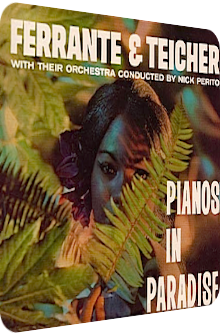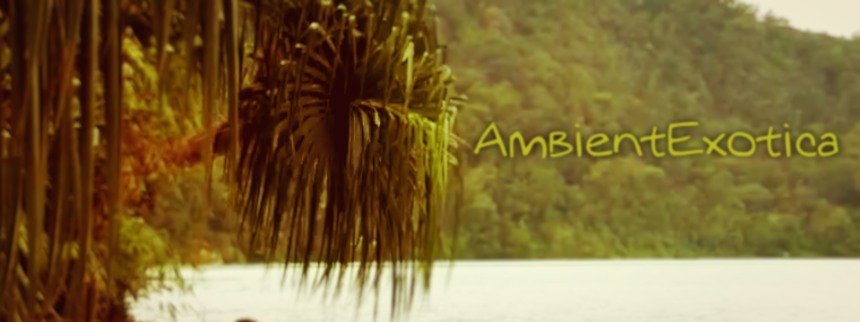
Ferrante & Teicher
Pianos In Paradise
1962
The thought of a piano-driven Exotica LP is a troubling one. The flamboyant genre breathes and lives due to the variety of instruments and the many inventive arrangements. In 1962, renowned pianists and close friends Arthur "Art" Ferrante (1921–2009) and Louis Teicher (1924–2008) try to make a dent in the Exotica realm with their signature instruments. And they succeed big time! Pianos In Paradise, released on the United Artists Records label, is one of my absolute favorites and has another advantage I deem essential for its enchanting aesthetics: it features a large orchestra conducted by Nick Perito. The danger of a thin, repetitive timbre or tonal range never appears on the horizon, for the many strings, brass instruments, flutes and exotic percussion devices such as bongos, congas and bamboo rods enlarge the scope of the production and work well with the pianos. Both pianists are never exclusively in the limelight. A reciprocating process takes place, allowing the involved orchestra members to shine in the many varied segues and sections.
12 tracks are presented, a large number of them true Exotica classics, some of them taken from the book of classic Jazz, others being symphonic standards, with one composition coming from the feather of Ferrante and Teicher. The material oscillates between uplifting adventures, calm beach sceneries and mysterious jungle settings, i.e. the clichéd but welcome ingredients that make Exotica records so great. Their status as classics implies that the renditions are accessible, very catchy and less convoluted, and sure enough, this is exactly what the pianists and the orchestra deliver: highly accessible melodies which are towering above the Easy Listening gallimaufry. I'll take a closer look at all 12 tracks below. Since the album is available in a re-issued digital form thanks to the Smith & Co. label, you can pre-listen to it on iTunes or Amazon MP3 with ease.
Pianos In Paradise is a bold album title, and so the opener has to be something special. And it sure is, for Tony Beaulieu's exotic Jungle Rhumba is unleashed. Launching with a three-to-four-note anacrusis on the piano which is followed by the respective answers from the excitingly grave orchestra strings, it is the bongo groove that revs up the tempo and turns excitement into frenzy. The tempo is high, the double bass backings conflate with Teicher's abyssal tone sequences which themselves are perturbed by piercing brass blasts. The chopped downwards spiraling piano melodies are purposefully rustic, but the many moments of glistening liquidity as well as a golden-shimmering glissando style of play make this a rather eclectic arrangement where Ferrante and Teicher are as important as Nick Perito's orchestra. This is a rather serious and cinematic Exotica piece; a bit too over the top, but refreshingly upbeat.
The following Shangri-La by the trio of Carl Sigman, Matty Malneck and Robert Maxwell changes the tempo and moves into languorous climes with a Hollywood-esque string thicket. It is one of the most impressive versions ever! A repeatedly beaten Chinese gong is intertwined with intensely yearning violins, paradisiac flute melodies and a superb coalescence of the pianists' talents. The guys play it easy, but that is expected, for the dreamy solemnity of the leitmotif has to be played in a heartfelt way. The strings lose their acidity for the moment and boost the lachrymosity, all the while glockenspiel glints and piano cascades float along. Ferrante and Teicher's take is most successful when the strings waft gently in the background and make room for a more intimate, smaller wideness. The culminating climax is strictly orchestra-driven, but this is no flaw per se.
Duke Ellington's Misty is next, a less performed gem in Exotica circles, and it is here where the strings shimmer in a vivaciously rose-tinted, but non-kitschy way. This is another superb tune. The euphony is tasteful, the reeds are silky, the piano melody in focus and the coziness phantasmagoric. The pianists' true skills are not enforced, the arrangement is less exotic rather than commonplace, but the moony setting has its qualities. My personal highlight comprises of a mere seconds, namely the conclusion that consists of a rising orchestra bell sweep. Another real treat approaches in the form of African Echoes, the only composition on the LP written by Ferrante and Teicher themselves. The scope is enlarged once more, the wideness is breathtaking. The duo envisions a safari in a wide Steppe. Various large claves, bamboo rods, a eupeptic punchy bass guitar and wonky-cacophonous strings lead to a celestial violin chorus with deeply hammering pianos and bongos. The greatest achievement is the transfiguring catchiness. One can almost smell the sunset.
Lionel Newman's Exotica hymn Adventures In Paradise is transformed into a gold standard: the legato of warped ukuleles, fizzling cymbals and amicable brass eruptions lead to the Hawaiian maracas-accentuated sun-soaked main theme. Played on the piano and various strings, its aqueous characteristics work splendidly with the refreshing violin washes and the elasticity of the Hawaiian strings. It is a great interpretation of a world-famous melody. This is Exotica! Side A finishes with Claude Debussy's Claire De Lune. With a runtime of over four minutes, this requiem is almost a clear-cut piano arrangement. Only scarcely does Nick Perito underpin the piano dialogue. The expected nocturnal breeze is all over this reduced piece which would have been a great outro, but fits well in-between the other tracks regardless.
Side B opens with Ernesto Lecuona's The Breeze And I, otherwise know as Andalucía. The pianists decide to make it the fastest song of the album, with the galloping bongos and rhythmical piano waves serving as a great backdrop for the flute-accompanied main melody. The strings and brass instruments grow in voluminosity, and the finale consists of glockenspiels, orchestra bells, gongs and greatly hammering piano sections. An uplifting take on an eternal anthem. The following Flamingo by Ted Grouya is especially close to my heart, although neither Andre Kostelanetz' 1954 take on Lure Of The Tropics nor Martin Denny's 1958 version on Primitiva are beaten. Still, the mellifluous orange-tinged warmth is tremendously soothing. Whenever the lead melody is played by the strings, flutes or brass instruments, Ferrante and Teicher advect effervescent piano droplets. This is the most majestic Exotica piece of the album. I am glad that there is not even a slight breeze of pompousness injected, since it would have destroyed the paradisiac jungle flavor.
While the second inclusion of Carl Sigman and Robert Maxwell, Ebb Tide, is all too romantic and kitschy with too saccharine violin layers, pathetic brass schmaltz but a genuinely great alto flute ending, Margarita Lecuona's Taboo brings back the seriousness of the opener and merges an intensely dark piano-pizzicato-string rhythm aorta with abyssal piano tones, their curiously echoey higher foils, rotor-esque bamboo rods and hollow bongos. Both the lament and murkiness are second to none, making the duo's take on Taboo a faithful reproduction of the gloomy original. The penultimate inclusion is originally written by George S. Clinton: Negligée is usually not part of the Exotica canon, and the reasons are plain and simple in this take. The oscillation between a dusky mystique and much warmer and amicable sections is definitely attractive, but the perceived heaviness of this piece makes it feel too big. Another stylistic inclusion expands the scope further, namely a mixed choir, a first on Pianos In Paradise and resemblant of Alfred Newman's and Ken Darby's Ports Of Paradise (1960), both of whom incidentally created the largest Exotica album there ever was.
egligée resides in Hollywood climes, with ever-changing patterns of sadness, majesty and gargantuan zeniths. I am not particularly fond of it as it neglects the evocation of paradise, but the apotheosis of the album is superb. Incidentally, this final composition was co-written by said Alfred Newman with Frank Loesser and is a definite Exotica classic: Moon Of Manakoora. Ferrante and Teicher's interpretation launches with Space-Age strings, stardust-covered piano waves and galactic ukulele twangs. The dreamy melody is fully fleshed out on the pianos and is backed by mellow woodwinds. The balance is exactly right. The moon-lit atmosphere is always the strongest when the pianos are in the spotlight, whereas the accompanying orchestral instruments fuel the grandeur without destroying the fragile mood. A great closer to an exotic LP.
Pianos In Paradise is surely not the über-milestone of the Exotica genre, but it is a high-quality work of a skilled duo of pianists who know what they are doing. It is also the most exotic work of Ferrante and Teicher which is pieced together by both Exotica standards and exotified material from Hollywood. The title is bold, as stated in the first paragraph, but it is justified and truthful. The orchestra does a great job under the watchful eyes of Nick Perito, and the fact that it is not only used as a mere backdrop, but an equally important base for the evoked jungle thicket is applaudable. The stylistic range of the presented material crosses all possible paths, from dreamy over mysterious to gleefully fulminant.
My favorites tend to be the compositions I know by heart anyway, among them the superb gentleness that is Flamingo, the dreamy Misty which is not associated with the vintage Exotica style at all and the pianists' own African Echoes which is sun-dried, blissful and can even be linked to the concept of coolness to this day. Fans of Martin Denny's later piano-focused works who do not know Pianos In Paradise yet will undoubtedly rejoice. While there are neither birdcalls nor Far Eastern instruments besides the Chinese gong on board, the exotic flavor is larger than on many other exotic works by pianists, Stanley Black, Ralph Font and Rene Paulo included. Recommended to everyone interested in Golden Age Exotica, and luckily available as a digital download.
Exotica Review 188: Ferrante & Teicher – Pianos In Paradise (1962). Originally published on Mar. 2, 2013 at AmbientExotica.com.
